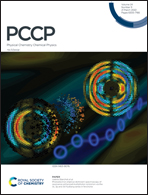Search for an exothermic halogen bond between anions
Abstract
The literature contains numerous instances where pairs of anions engage in a stable complex with one another, held together by hydrogen, halogen, and related noncovalent bonds, within the confines of a polarizable medium such as a crystal or solvent. But within the context of the gas phase, such pairs are only metastable, higher in energy than separated monomers, whose favorable dissociation is hindered by an energy barrier. Quantum calculations search for pairs of anions that might engage in a fully stable halogen-bonded dimer in the gas phase, lower in energy than the separate monomers. Each Lewis acid candidate contains an I atom attached to an alkyne, alkene, or alkane chain of variable length, terminated by a O− or COO− group, and decorated with electron-withdrawing CN substituents. Also considered are aromatic systems containing I and COO−, along with four CN substituents on the phenyl ring. Lewis bases considered were of two varieties. In addition to the simple Cl− anion, an NH2 group was separated from a terminal carboxylate by an alkyne chain of variable length. Exothermic association reactions are achieved with Cl− paired with CN-substituted alkenes and alkanes where the I and COO− of the Lewis acid are separated by at least four C atoms. The energetics are especially favorable for the longer alkanes where ΔE is roughly −30 kcal mol−1.



 Please wait while we load your content...
Please wait while we load your content...